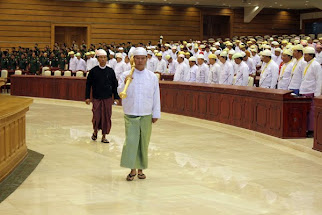
Karen refugees who fled the fighting between government forces and the Karen Independence Army huddle together for safety in the jungle, in this file photo. Photo: Mizzima
KNU peacemaking committee Secretary Pado Saw David Htaw said that the KNU plans to prioritize the issue because internal refugees need to return to their villages and restart their lives.
“We will give second priority to the issue regarding refugees in Thai camps along the border area, because they don’t have as many problems getting food and shelter as the Internally Displaced People (IDPs) inside Burma,” Pado Saw David Htaw said.
Many refugees inside Burma have to hide in remote jungle camps in the Pegu Region and in Karen State. Food aid groups along the Thai-Burmese border can sometimes provide for IDPs, and the foreign-based Backpacker Health Worker Teams and KNU medical units can provide limited health services to IDPs, said the KNU.
There are around 100,000 IDPs, according to some estimates. Many villages have been burned down by Burmese troops, and many IDPs can not return to their villages because land mines have been planted by government and ethnic armies. DPs are homeless for various reasons, the first being renewed fighting since mid-summer 2011. Dam construction in Karen State has also been a factor.

This file photo shows Shan war refugees living in the jungle in grass shelters in Shan State. Photo: SHRF
Another key issue to be discussed, said David Htaw, is KNU-connected prisoners.
There are around 150,000 refugees in nine camps in Thailand with food and shelter provided by the Thailand-Burma Border Consortium, which is funded by international organizations. Most of the refugees are Karen
who fled from their homes because of the fighting.
Most of the refugees’ homes and farmland have been destroyed and landmines have been planted in their areas.
A refugee who fled from Paingkyon Township to the Nu Po camp along the Thai-Burmese border told Mizzima, “There is only empty land in our villages. No one has solved the problem. Even if we want to return to the area to farm, we don’t have oxen and carts. Who will help us?”
A Karen refugee who fled three years ago from Kadimu village to the Mae La camp told Mizzima, “Here, we don’t know what our future will be. If we are sent to resettlement countries, it’ll be good for our children’s education. To return our villages, we’ll need guarantees that we can make a living in safety.” She said she fled because her village was burned down in February 2010 by the Burmese army.
Refugee groups say that both the Burmese government and the KNU have a responsibility to create conditions where internal and external refugees can return to their homes to restart their lives. After a genuine cease-fire, refugees will need support, including access to their farmland, seed crops, equipment and national identification cards.
International aid groups have called for the Burmese government to allow them full access to the area, in order to start the rebuilding process and national reconciliation. So far, the government has prevented full access to the area.

















No comments:
Post a Comment